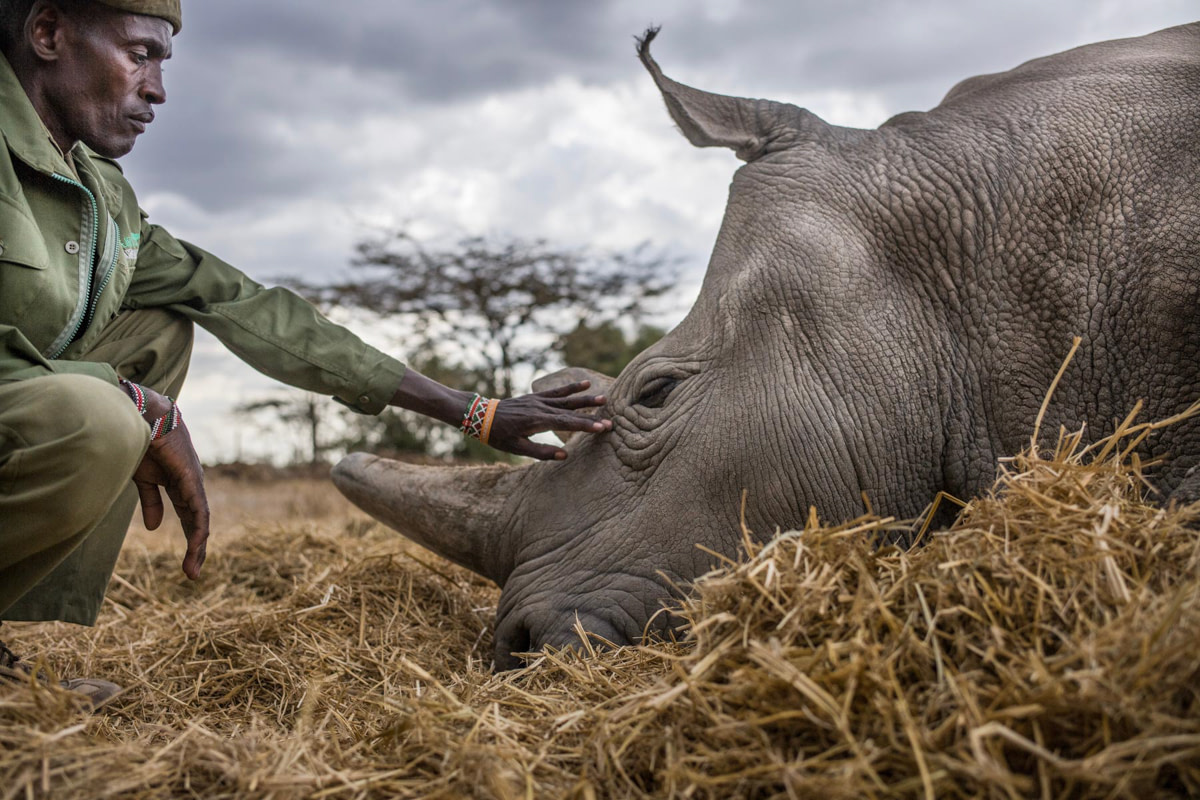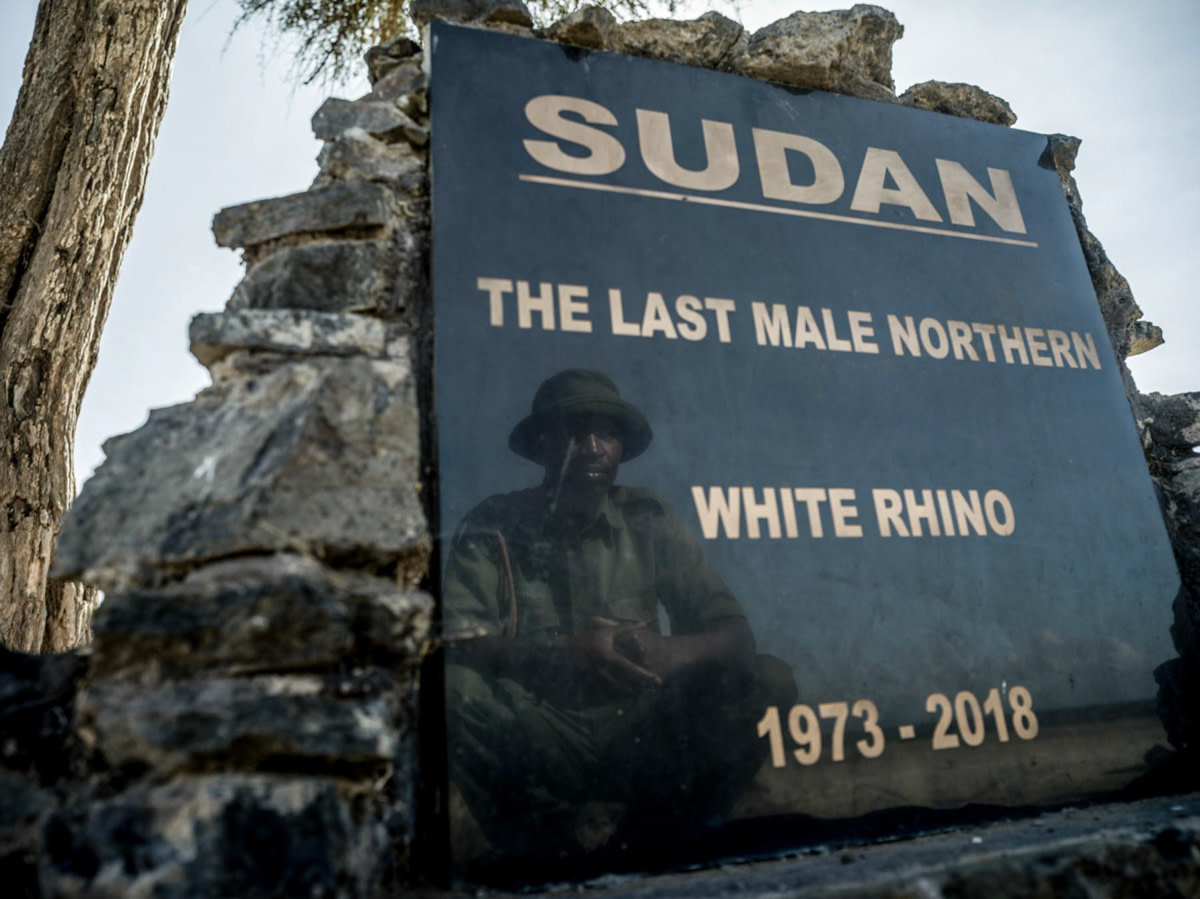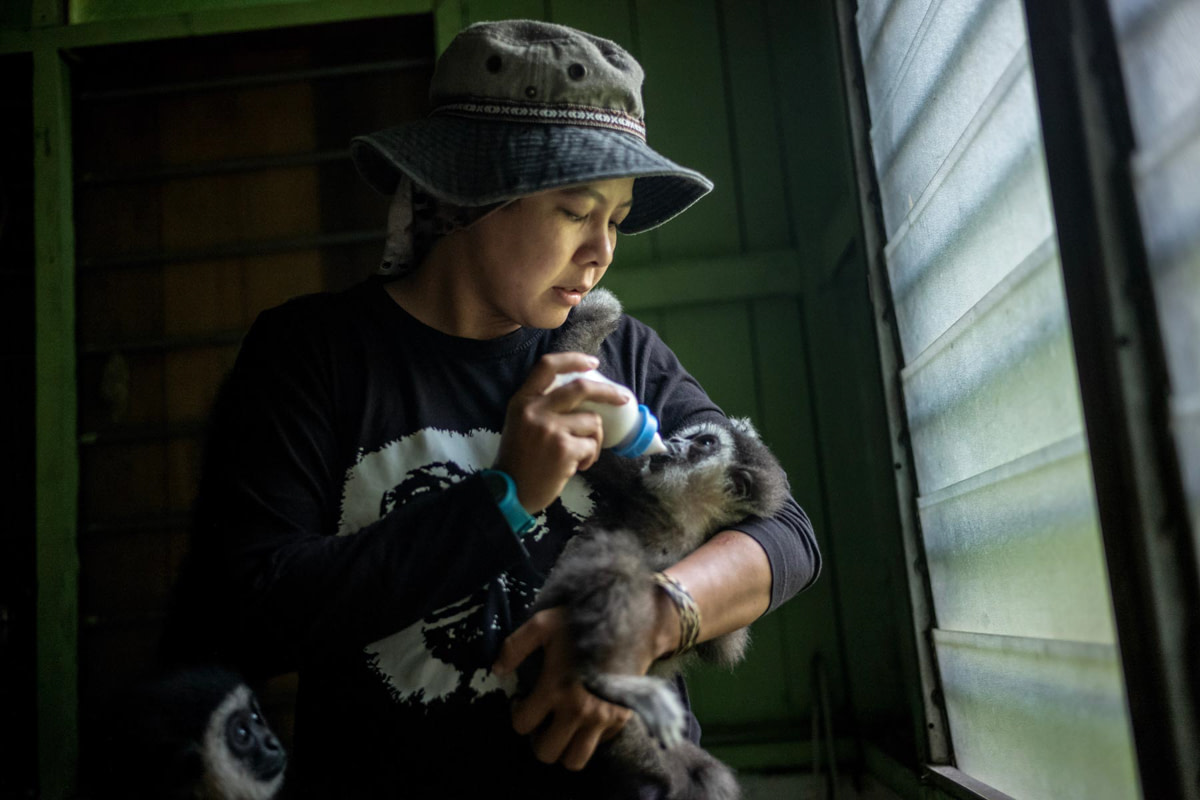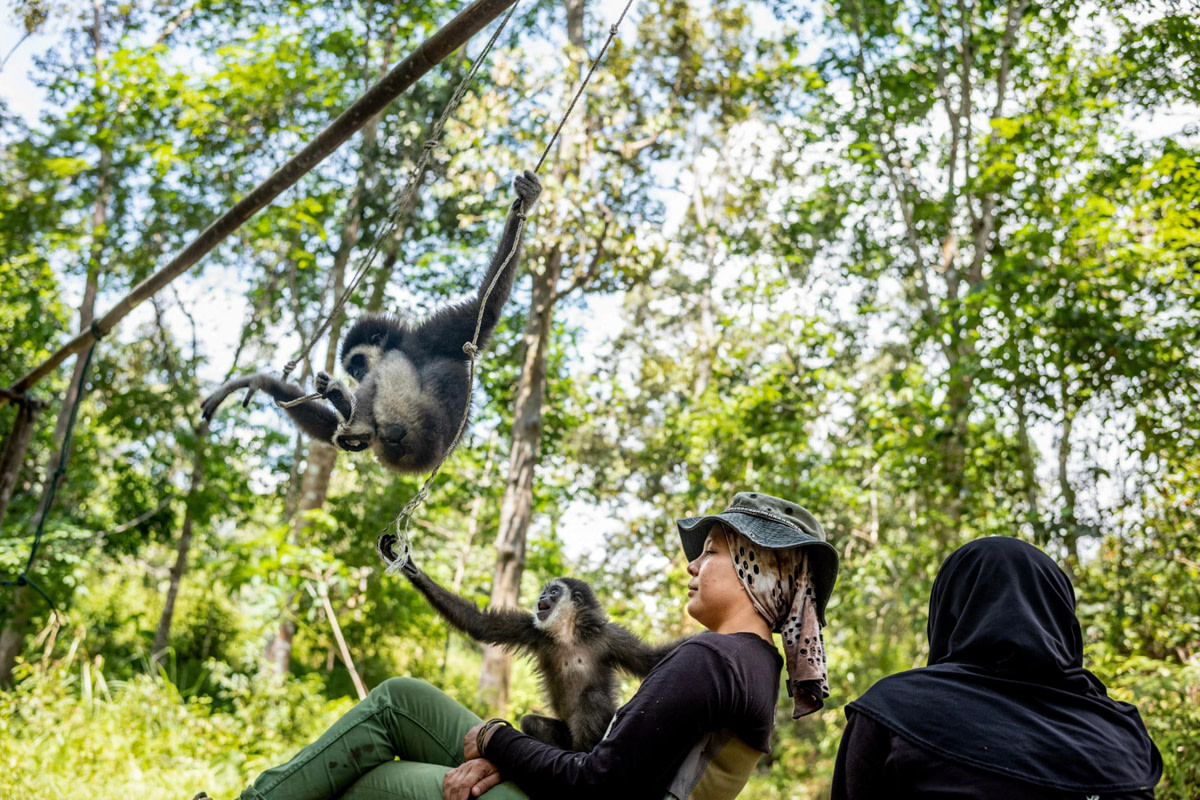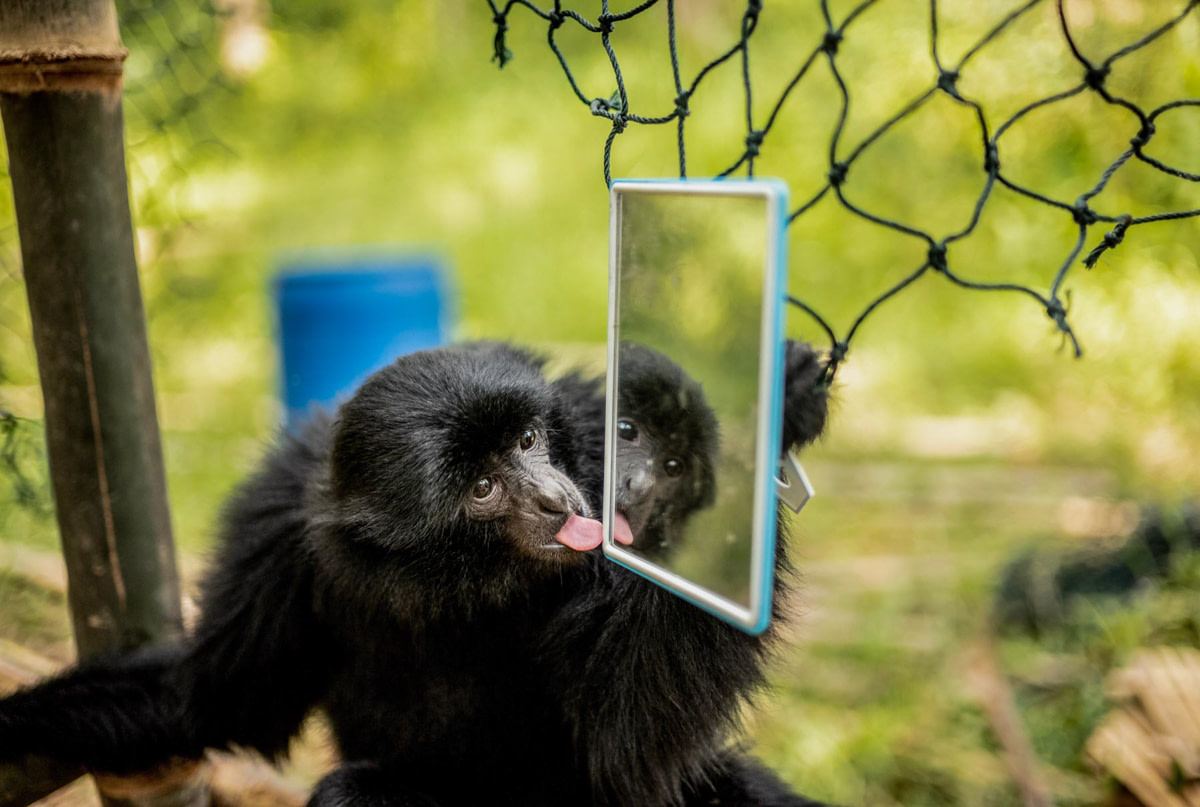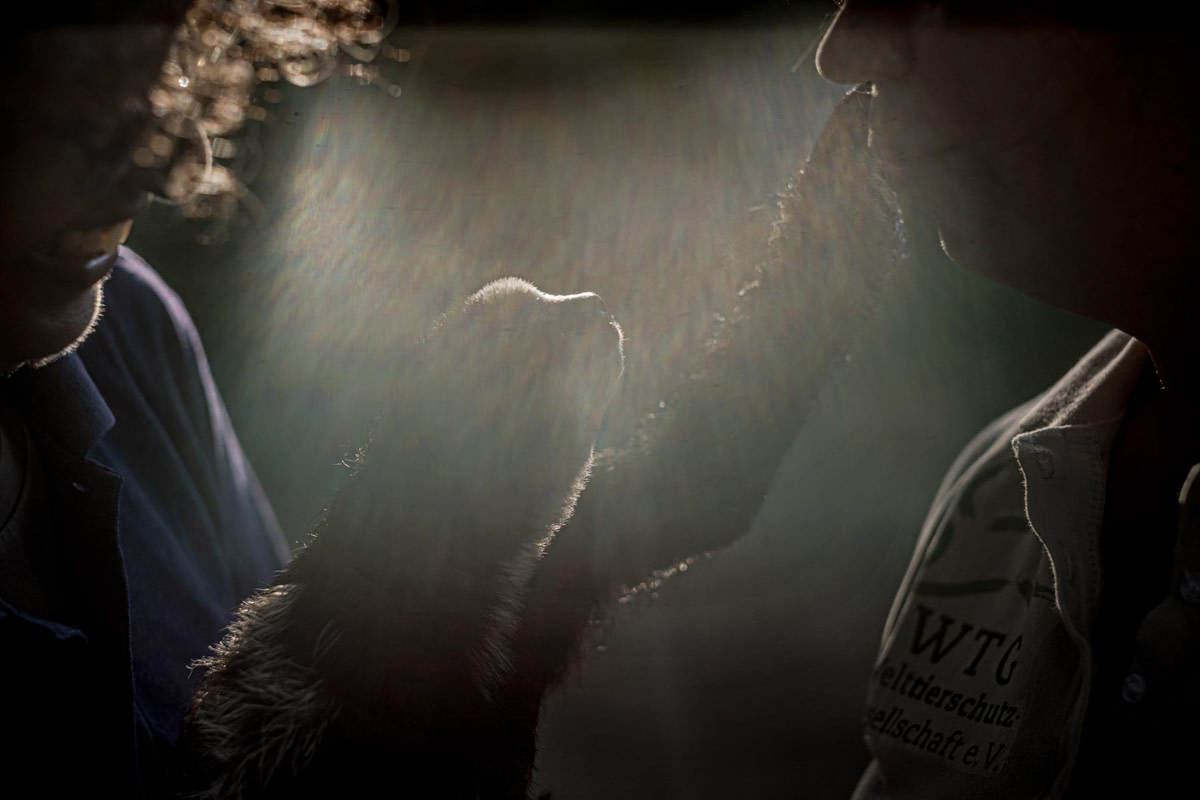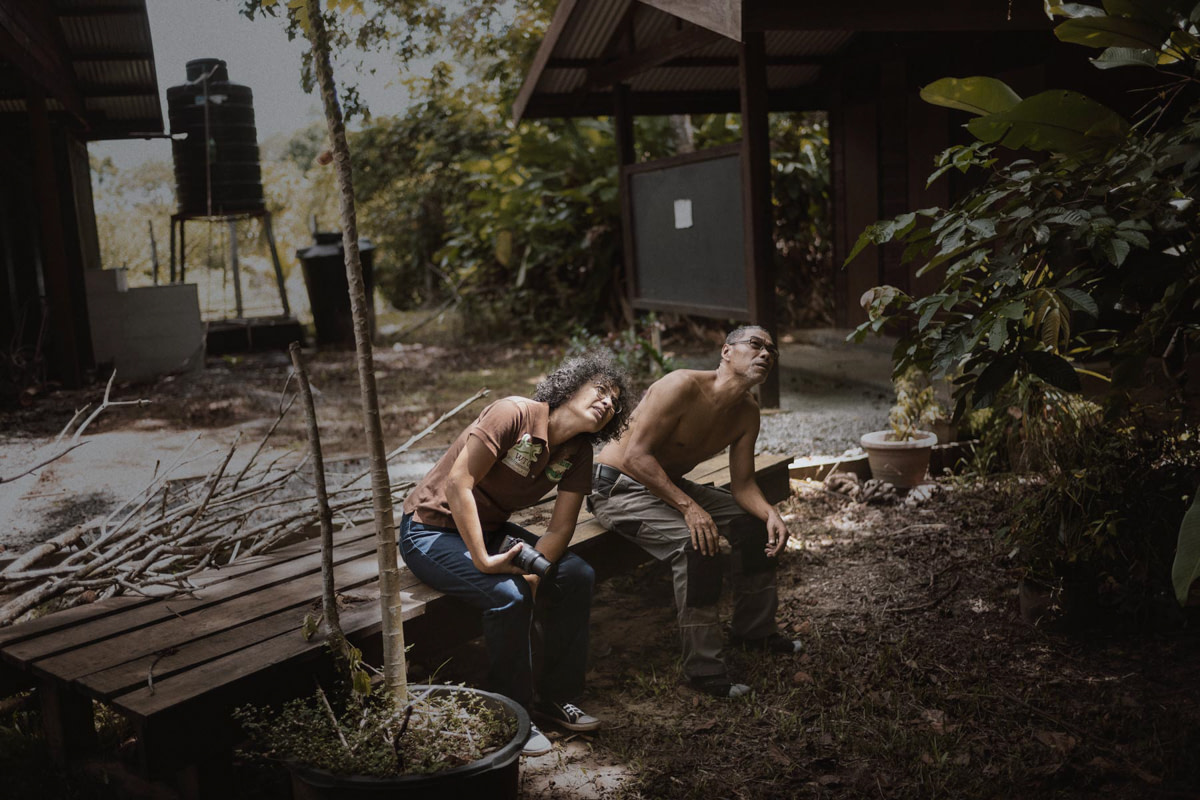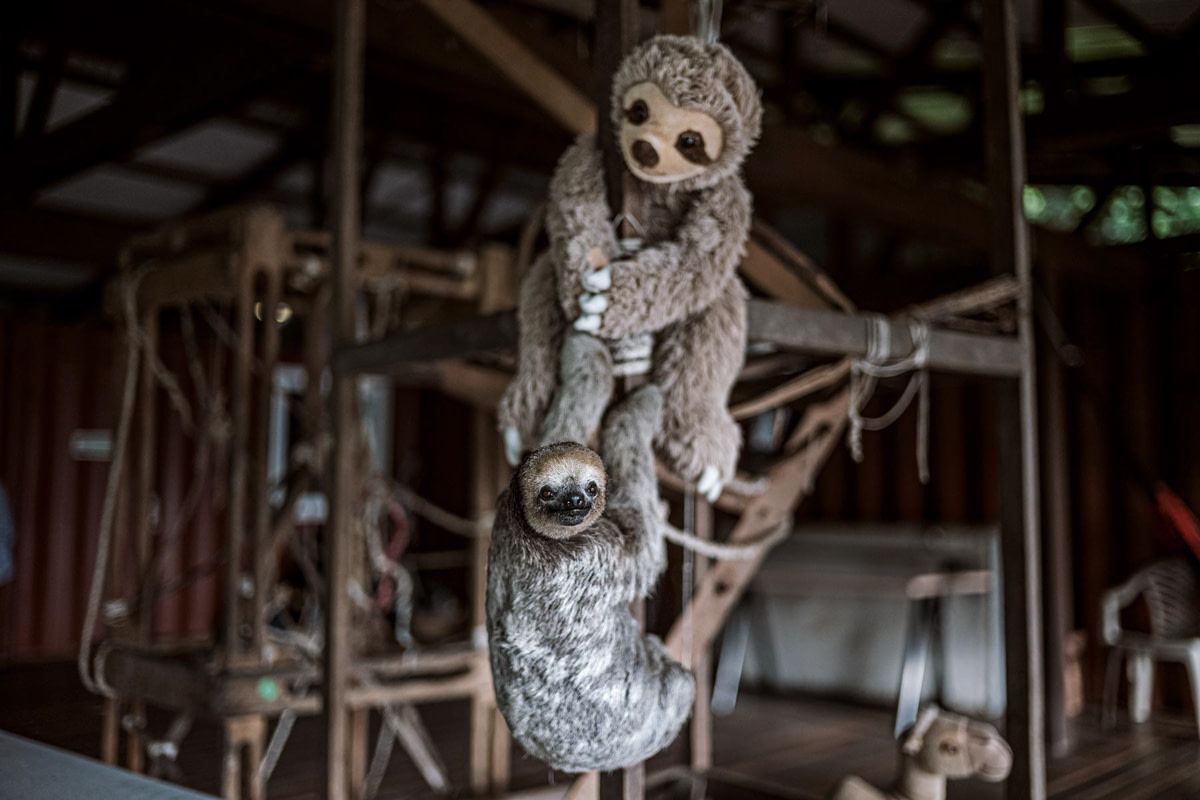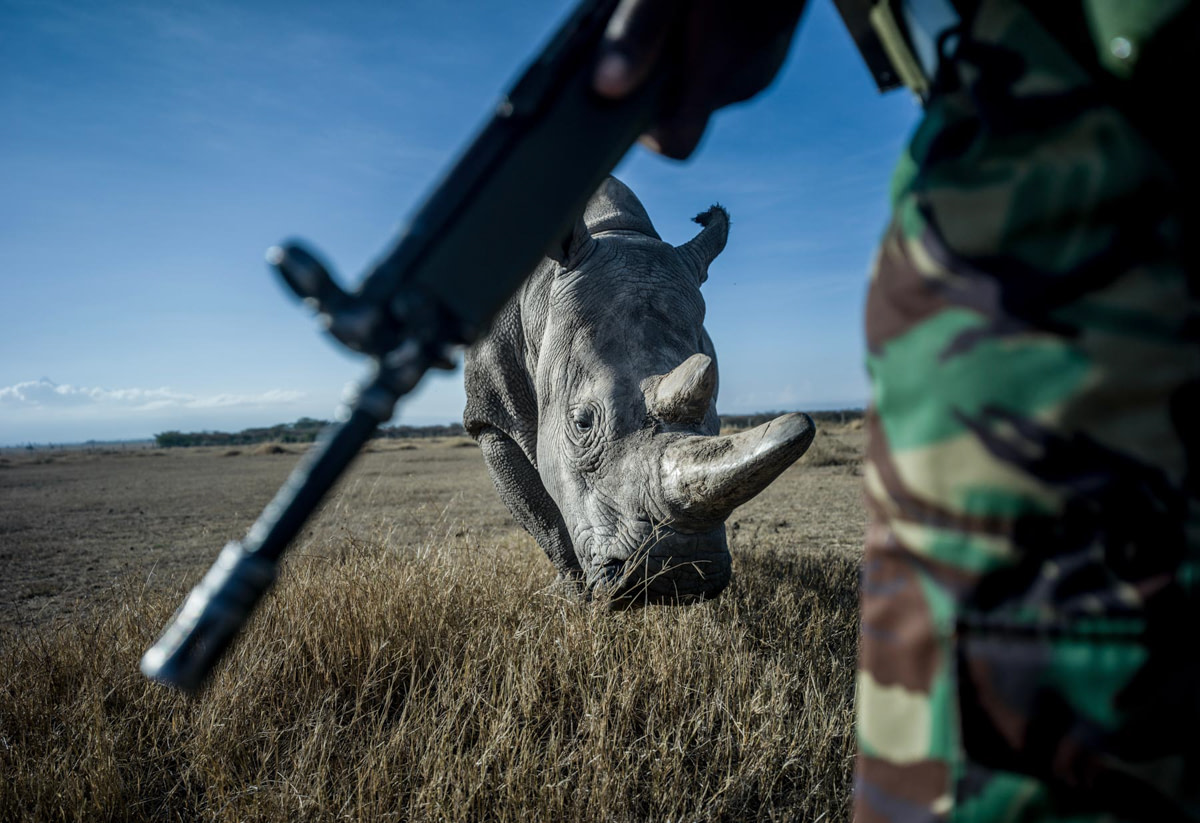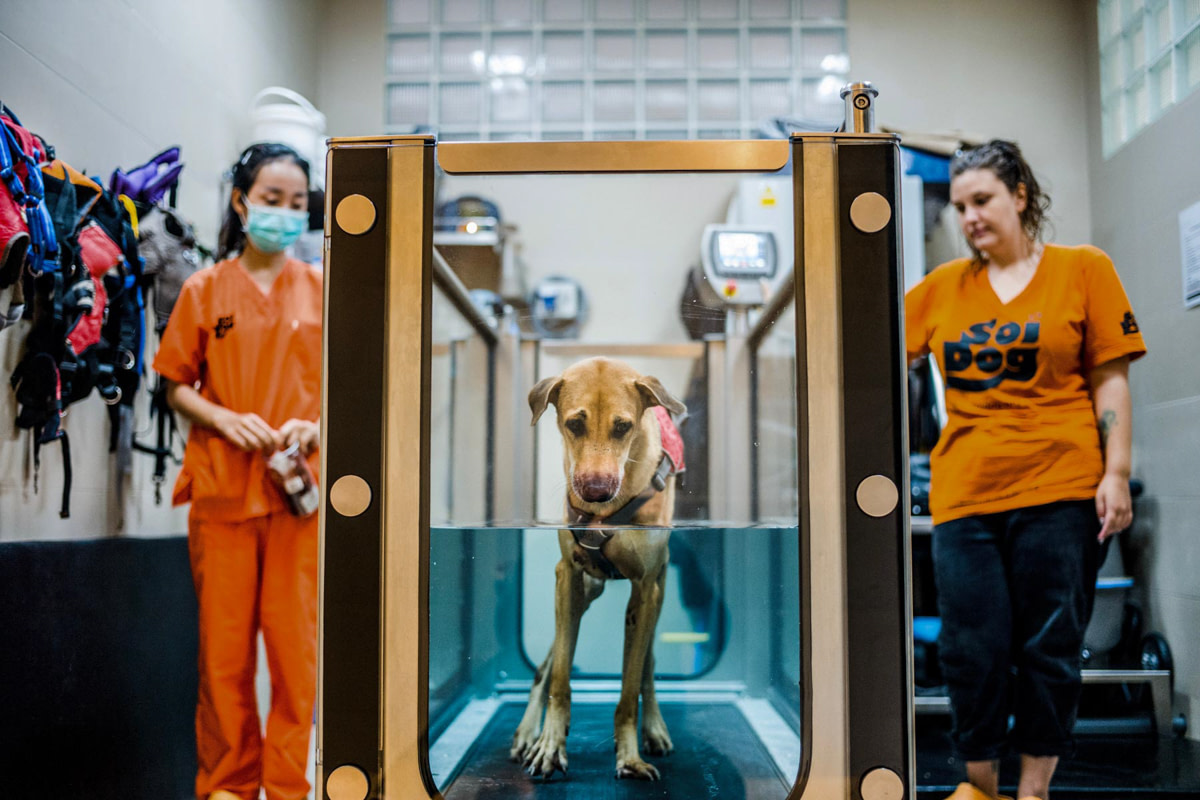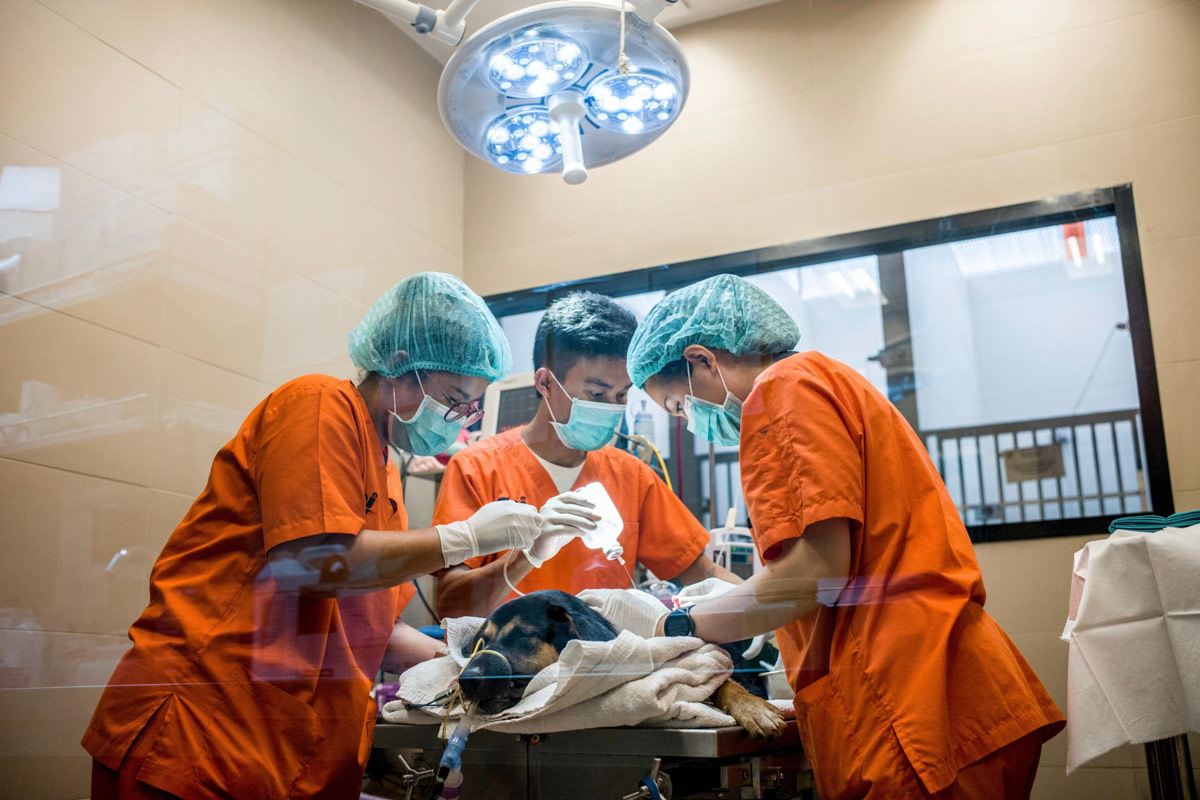Head northern white rhino caretaker Zacharia Kipkirui, pets Najin on her head while she naps in an open field at Ol Pejeta Conservancy in Central Kenya.
Justin Mott / Kindred Guardians / We Animals
Our latest contributor, Justin Mott (New York Times, Washington Post, Smithsonian, Greenpeace, WWF), has been documenting people around the world who dedicate their lives to animal conservation and welfare. Based in Vietnam and covering assignments globally, Mott is an avid animal welfare advocate and in 2018 pivoted the focus of his work to wildlife photojournalism and conservation photography. We spoke with him to find out more about his work and what inspired his current project, Kindred Guardians. The interview has been edited for length and clarity.
Follow Justin Mott’s work: www.justinmott.com
Photographer: Justin Mott
We Animals (WA): Which came first for you: animals or photography? Can you tell us a little about your path to where you are today?
Justin Mott (JM): Animals came first. I grew up in a small town in Smithfield, Rhode Island and my neighbourhood was surrounded by nature. My father taught me to respect wildlife. He always told this story from his childhood about when he killed a robin with a pellet gun and that he felt bad for that moment his entire life. I never found out if that story was true or not, but it had an impact on me. People can underestimate how impactful our parents can be and how their teachings lay the foundation for our interaction with the environment.
Zacharia Kipkirui, one of the primary rhino caretakers at Ol Pejeta Conservancy visits the gravesite of Sudan, the last male northern white rhino who passed away in 2018.
NPR (National Police Reservists) have a moment of prayer before they go out on an overnight patrol of Ol Pejeta Conservancy in Central Kenya. The armed men patrol the 360 km2 (140 sq mi) not-for-profit wildlife conservancy around the clock and protect the rhinos and other animals from deadly poachers.
WA: What do you enjoy most about your work? What do you find most challenging?
JM: I’m inspired by the people I choose to document; I’m truly fascinated with them. They live a life of purpose, and they make a difference for the better, every single day. I just have so much respect for them and they push me to be the best I can possibly be at my job.
The most challenging part is getting people to trust you and I completely understand why. These people put everything they have into their work and to let you into that world takes a lot of trust. Add to that, I need the time to tell the stories accurately and with depth so I’m often shadowing them for a week or more, which is hard to put up with.
WA: Your project “Kindred Guardians” documents people around the world who dedicate their lives to helping animals in need. Why is this an important project?
JM: It’s important for me for three reasons. Firstly, documenting the people I feature in the project highlights the work these crusaders do. They don’t do it for credit, but it doesn’t mean they don’t deserve it. Secondly, I hope the smaller story brings attention to the larger situation. Take the gibbons story for example: I want people to see Bam’s dedication to her work rescuing and rehabilitating Malaysia’s gibbons but also to see and understand the issue of the pet trade industry and what it does to wildlife. Lastly, all the images I take are donated to the organization or individual featured. Many rely on donors so it’s imperative they have powerful images and stories that show the work they do and the need for financial help.
WA: You’re good at getting very close to your subjects – both the humans and the non-humans – seemingly without interfering with their space and their life unfolding. How do you integrate yourself into a project, a space?
JM: Thank you for saying that. I spend a lot of time researching and communicating with the subjects that I’m planning on featuring. I like to earn my space before the shoot by being clear about what I’m after and again when I arrive. Even if they agree ahead of time, not everyone is comfortable from the start, so I ease into it depending on their body language, both for people and animals. Getting close is an ethical responsibility as well: I need to make sure it’s safe for the animals, safe for me, and that it makes sense for the story. If a caretaker must hand feed the gibbons as infants to rehabilitate them back into the wild, it makes sense for the caretaker to get close, but I must contextualize that.
WA: How much creativity can you as a photographer bring to a scene? You’re reporting as a journalist, but how much are you also trying to include your perspective as an eyewitness, as well as your own creative expression into the frame?
JM: For me, creativity comes with time and patience. The more time I have with people, the more I can understand their story and their connection with the animals, and the more time I have to humanize them, capture the nuances of their work. For example, take the story I did about Monique Pool, the woman famous for her sloth rescue in Suriname. After several days I started to observe that she is periodically looking up into the trees for sloths, even when she’s driving (that was a bit scary). If I was doing this on a carefully budgeted assignment, I wouldn’t even have time to see that.
When asked about the future of sloths in Suriname Pool explains, “I’m worried for them because of climate change, deforestation, and an increase in illegal gold mining. Suriname is the most forested country in the world and the most beautiful country and if we can conserve it, we have the opportunity to set an example for the rest of the world.”
I also feel I can be creative with sequencing my story; I find great joy in the process of putting together the story from start to finish for a slideshow or a layout. I love thinking about how images bookend and complement each other, how one image can lead into another.
Ostrich, a formerly rescued sloth who now lives nearby the rehabilitation center in the wild stops in for a visit.
WA: Is there any particular photograph you’ve shot that you think represents your work and what you’d like to communicate to the world particularly well? Can you tell us about this image – details about how and why you shot it?
JM: For an obvious reason this image has an impact on people and represents my project perfectly. The man holding an automatic weapon to protect the world’s last two northern white rhinos. This came about as I was documenting the caretakers of the rhinos and the patrolling armed rangers came by to talk to the caretakers. They patrol the grounds daily and risk their lives from deadly poachers. I framed the rhinos through the weapon and while yes, it’s obvious, I feel it’s clear and powerful and hopefully causes people to take a moment.
John Mugo, 37, a member of the NPR (National Police Reservists) protects and patrols the grounds of Ol Pejeta Conservancy from poachers with Najin in the background. The rhinos have been poached almost to extinction for their horns to be used in traditional eastern medicines in China, Vietnam, South Korea, and Taiwan and in Yemen for dagger handles.
WA: If you could issue an invitation to other photographers to take up animal photojournalism, what would you say? If you could issue an invitation to the media to include the work of animal photojournalists, what would you say?
JM: I’d say don’t be discouraged that big-name photographers or big-name media outlets have done the story you want to do and don’t be intimidated by them. Do the story your way and reach people your way. The digital world is new and exciting and much more accessible to all of us and that is a blessing and a curse so be responsible in your storytelling and in the way you showcase your work. Be creative and persistent. I’ve had my work published in major newspapers like The New York Times but often the biggest impact I’ve had is from the right person seeing my work at the right time on social media. Never underestimate the world, you never know who’s going to see your work.
Aiw Wongla (left), 26, and her assistant Marlen Krieger (right), 24, make up the physiotherapy unit at the Soi Dog Foundation in Phuket, Thailand. Daily they train with dogs doing hydrotherapy, massage, acupuncture, and laser treatment. They both state that helping a dog walk again is the most rewarding part of their job.
A German tourist hand feeds milk to a puppy he found abandoned at a temple in Phuket, Thailand. He brought the puppy to Soi Dog for sterilization.
WA: When preparing for a field assignment, what’s your go-to camera bag kit?
JM: I use a Leica M System for everything I do. I love a small and minimalistic set up, no frills, so I can focus on exactly what’s in front of me and not on me. Ninety-five percent of what I shoot is with a Leica M10D and a Leica 35mm 1.4 lens. This kit forces me to move more and to think and be more present. I like having gear that forces me into good habits. This setup does that for me.
WA: What’s next for you in your work?
JM: Waiting for the world to open. I’m compiling individual stories that all fit into a larger theme that I hope to culminate in a book and exhibition. I’ve got some amazing stories lined up such as a story about rare turtles, a rope-repelling reptile-saving crusader, and much more.
We Animals is now offering these astonishing visuals of people caring for rhinos, dogs, sloths, gibbons and pangolins in Asia, Africa and South America. These Kindred Guardians, as Justin calls them, prove to us a different relationship is possible.
Join us in conversation with Justin Mott in Episode One of our new Instagram Live Series “What Is Animal Photojournalism?” hosted by We Animals founder Jo-Anne McArthur. Tune in.
All images copyright Justin Mott. Follow Justin Mott’s work: www.justinmott.com
Photographer: Justin Mott
Did you know? Our stock platform offers 30,000+ photos and video clips of animal issues around the globe. Non-commercial (free) and commercial licensing available.


